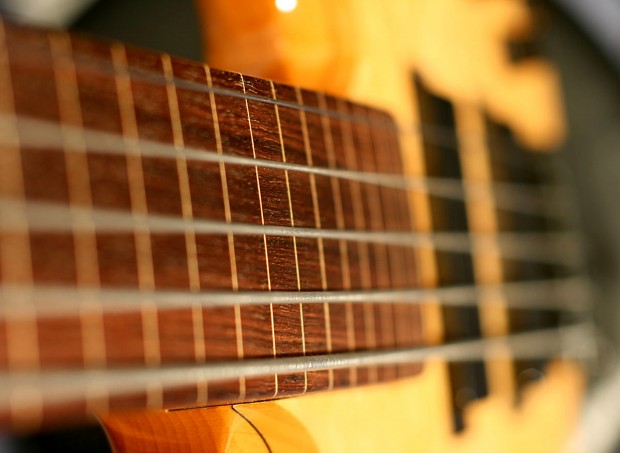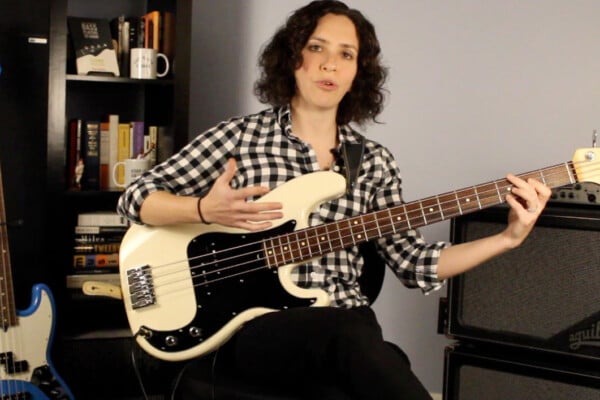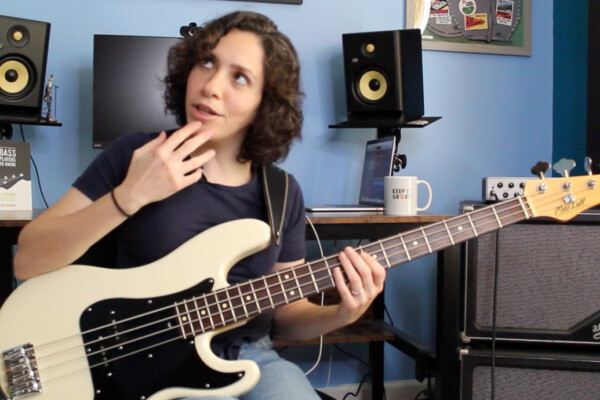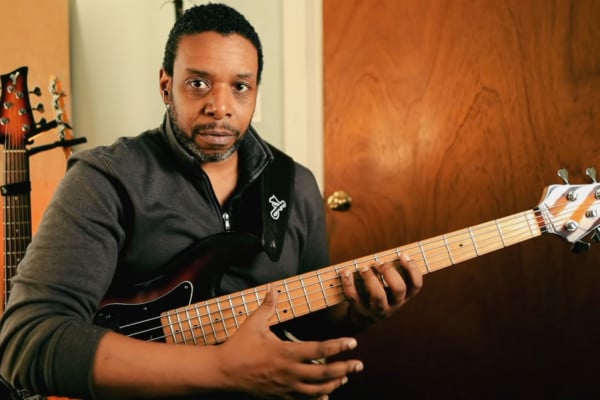Dealing With Songs That Go Beyond Your Last Fret

Q: I have a student entering his final year of secondary education. He has just purchased a 5-string Fender Jazz Bass. He is focusing on two handed tapping for his music subject. My worry… much of the music we have accessed (“Overjoyed”, “Rock and Roll” Bass Solo, etc.) requires between 21 and 24 frets according to the tab. The 21st fret on most basses is the end of the neck. As I am as new to tapping as he is, I am wondering what to do next! Any advice on adapting to suit his bass would be gratefully received.
A: I have students in a similar position. So much of the music played today is on instruments with a 2-octave range (per string) or higher.
There are only really a few options that I can think to recommend:
- Drop some of the line an octave.
This could be just the part that extends beyond the range of the instrument or an entire fragment of the line, so that the octave shift is more musical and less abrupt. - Use artificial harmonics to access the higher notes.
I think that this is the “cooler” and potentially more inspiring choice for the player because it really gets them exploring the sonic capacity of the instrument in an interesting way.
You mentioned that this was in a tapping context. You can tap on the string and get the same effect as an artificial harmonic. Example: hold a note with your left hand and tap the string an octave up (quickly, and more like a “doink” where you just peck the string with your right hand). You should hear the fretted note ring out in a higher range than fretted one.
The pitch will also change (just like a harmonic) when you alter where you are pecking the string with the right hand. Same goes for creating artificial harmonics the “normal” way.
Dr. D has a column on artificial harmonics here on No Treble to get you going, if you have any questions about how to make an artificial harmonic on the bass.
And here is a video of Rufus Philpot demonstrating artificial harmonics:
Readers, this is a great place to chime in. How do you tend to deal with playing something that extends the range of your instrument? Please share in the comments.
Have a question for Damian Erskine? Send it to [email protected]. Check out Damian’s instructional books, Right Hand Drive and The Improviser’s Path.




The suggestions in the post are okay and worthy of trying for reasons stated, but if they want to access the extended notes in real-time, neither of the suggestions quite fulfills the requirement. One additional option, short of buying an extended range bass/instrument, would be to use a pitch shifting pedal that shifts at least an octave up.
Two options are the EHX Pitch Fork and the Digitech Bass Whammy. The Digitech has a better superior bas note reproduction, but the EHX can spilt intervals up, down, and up & down simultaneously; can gliss the interval(s) via expressional pedal (like the whammy), and has a latch mode; that means it will only engage as long as the switch is depressed, which can be more convenient clicking the effect one-and-off if only extending for a short break. With the Blend dialed to full wet, you will only get the synthed note on the EHX, which can sound a little synthy-glitchy all by itself. Alternatively,he replicated notes on the Digitech bass whammy sound pretty amazing, esp. compared to other bass pitch shifters – including previous versions of the itself.
Ultimately, nothing beats being intimately confident and familiar with your instrument and learning to be effective within the constraints and available options it affords. The bass in particular is an amazing testament to the power and beauty of of its simplicity. After many years of learning, experimenting and playing, I am continually amazed with the universe contained within those four – yes, four – strings (personal preference, not throwing shade). Best favor one can do themselves is to be aware of all options available to them, to not be afraid to experiment without prejudice, and learn how to always leverage leverage new discoveries.
An easier solution might be to just transpose the tune 1-3 semi tones. That is unless the tune already uses the low B.
Surprised nobody suggested this – you have two viable solutions. For one or two tunes in a set, if unwilling to play those couple high notes faking some harmonics – just tune up the G string to B on the fly – and play what you’d normally play on the open G (G-A-Bb) in first position on the D string for that one tune. I’ve done it – lighten the gauge of the G string so you don’t snap it tuning up, You can tune on-the-fly and tune right back down when done with those tunes. Don’t even need to play the whole song raised – just crank it up to B a few bars before the ‘big solo’ or whatever.
A more permanent solution –
If your the student doesn’t need the low B string for anything at this point in his/her bass career, and is unwilling to purchase a 24-fret instrument, and if you *absolutely, positively* needed those fretted notes, – you could re-string and use the 5th string tuned to high C. I know a few players using 5-strings in this way – nothing wrong with it – you’ll be out a set of strings and can switch back in 20 minutes if necessary.
Another viable option – every pro player should carry a spare axe anyway no matter what – invest $300 in a decent 24-fret Asian de-light.
Me… unless it was some long extended passage – I’d probably fake those few notes with some harmonics – fret them an octave down and use first finger on the right hand to sound the harmonics… or just ‘tap’/’slap’ right over the octave notes – It’ll sound good and will offer a little “show” for the audience.
Hope these ideas are of some help.
Haha awesome input “dad” – I’m on to ya. But good ideas… better than using a whammy pedal, who does that? ;-)
that is SO cool ! Can’t chat, off to plug in and try this out!